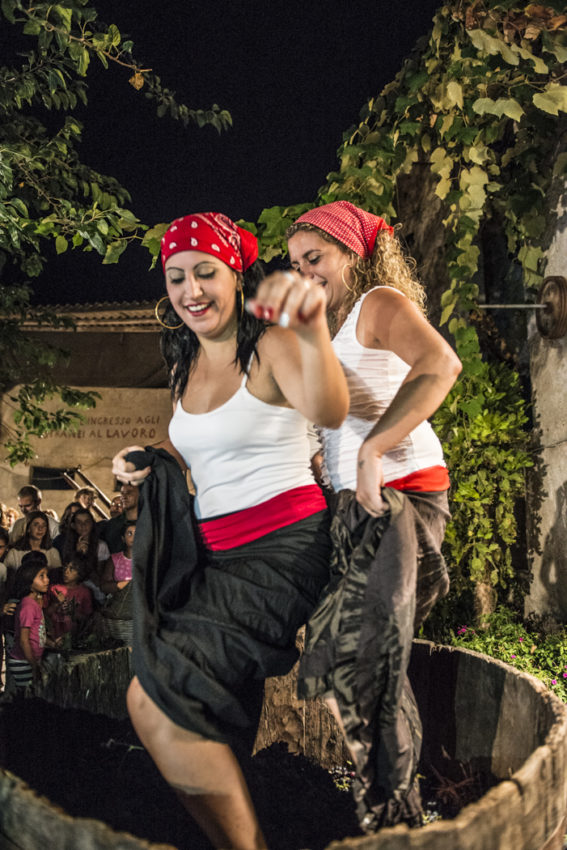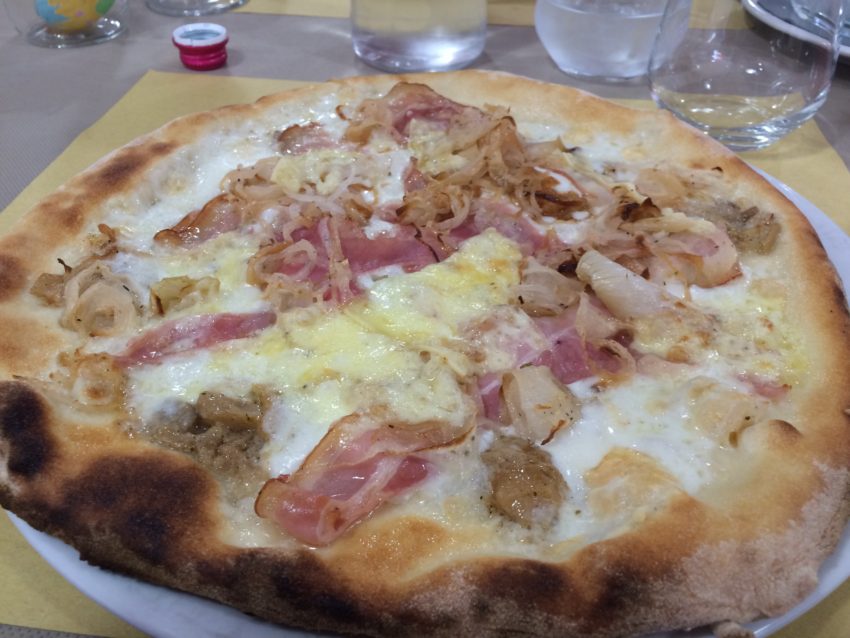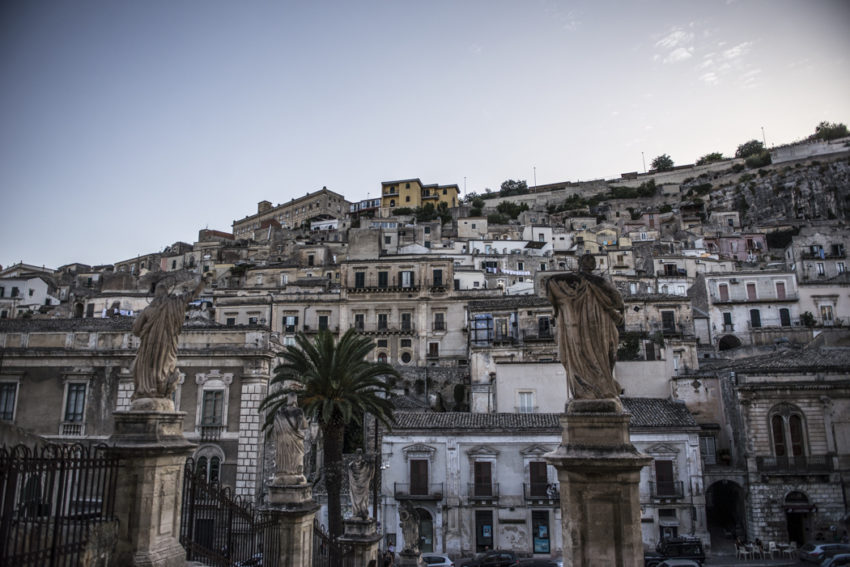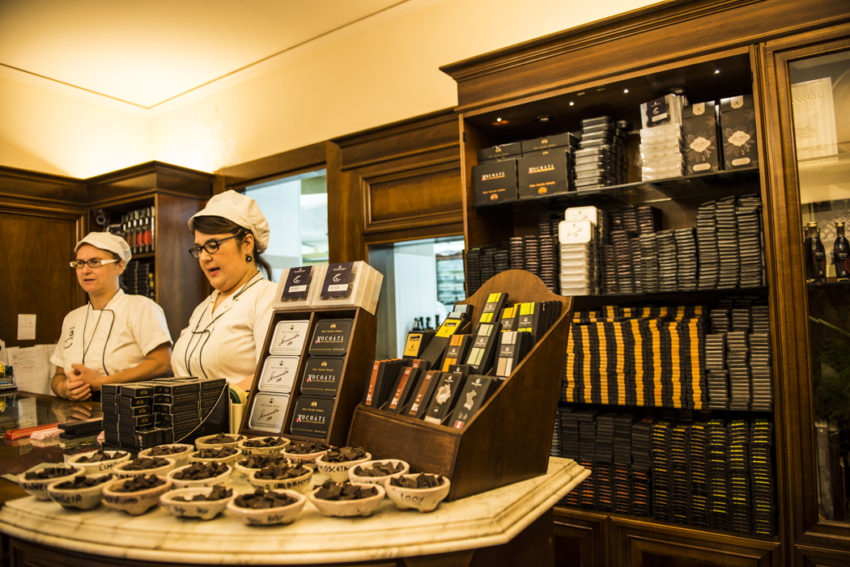The Baroque Triangle: Sicily’s trail of the Renaissance’s gift to architecture

SECOND OF A TWO-PART BLOG
NOTO, Italy — We sat at a table on a small cobblestone street leading up to one of the endless number of Baroque churches in Noto, one of the prettiest little towns in Italy. We’re eating an almond granita, Sicily’s signature icy, fruity dessert in which every wet, cold bite makes you think a Sicilian will complete the perfect picture by suddenly breaking into song.
Soon, one did. In front of us, in the doorway of the little shop, a bald man in a bright red apron started strumming a guitar and singing “Vitti ‘Na Crozza.” That’s a Sicilian ballad meaning, literally, “I Saw a Homeless.” It’s about an 80-year-old Sicilian woman taking a hard look at death after a miserable life. The song is in Sicilian, a language that seems as close to Italian as English is to medieval Bulgarian.
[googlemaps https://www.google.com/maps/embed?pb=!1m14!1m12!1m3!1d1621281.543439281!2d12.917467140072093!3d37.47097926881619!2m3!1f0!2f0!3f0!3m2!1i1024!2i768!4f13.1!5e0!3m2!1sen!2sit!4v1460210402456&w=600&h=450 align=”alignright”]
Sicilian is spoken exclusively in this part of rural Sicily. We’re in Sicily’s rugged southeast where towns hang from cliffs and are shaded by Mediterranean pine trees. It’s where 18th century palaces glisten in the sun and the only sounds in lightly tread piazzas are birds and the breeze coming off the nearby Mediterranean Sea. Maybe if the old woman had lived her years in this area, she wouldn’t cry, “Si nni eru si nni eru un sacciu unni.” (“My years, my years are gone and I don’t know where.”)
My girlfriend, the uber-talented photographer Marina Pascucci, and I continued my 60th birthday celebration on the trail of what is known as the Baroque Triangle. It’s a series of small towns dripping with Baroque architecture. Baroque style was born in Renaissance Italy during the late 16th century and designed to show off the wealth and power of the rapidly expanding Catholic Church. Baroque churches are extravagant, abnormal, garish and, depending on your taste, either ostentatious or jaw-dropping gorgeous. By the middle of the 17th century, Baroque architecture had spread, like the invention of pizza, throughout Europe and South America.

I’d seen it on a compact scale in Riga, Latvia. However, that was a November in Latvia and the cute capital was covered in snow. Some of my pictures are blurry from my shivering hands. In Sicily last week, it was mid-70s and bright sunshine. It was the perfect time to spend two days negotiating the small highway winding its way up the Sicilian hills.
From our base in Syracuse, we worked our way south, then west, then north. Here’s a thumbnail look at three Baroque Triangle towns that you should not miss in Sicily. Also, at the end of the day, there is always a gorgeous Sicilian beach nearby:

NOTO
At Catania airport, we rented a car, a must Marina said. You can take buses from Syracuse, but public bus spottings in Sicily are as rare as Bengal tigers. Marina is beautiful but no one looks good waiting for hours at a rural bus stop. Anywhere.

Noto is only 20 miles down the Ionian Coast from Syracuse. We passed the tiny town of Avola but it’s tiny in size only. It’s the home of Nero d’Avola wine, Sicily’s most famous wine which has gone from these hills to restaurants around the world. As we turned inland, we drove right into a long wall of rocky hills covered in shrubs all the way up to the plateaus.
At the top of a hill we came to Noto where a huge, ornately decorated sand-colored archway led us into what many call Sicily’s prettiest street. Walk through the gate, which looks like something that once greeted victorious Roman armies, and Corso Vittorio Emanuele is one long Baroque boulevard. It is pedestrian only. You can walk past the Baroque palaces and churches without worrying about getting clobbered by a Fiat.

How Noto became a Unesco World Heritage Site is a tip of the fisherman’s cap to Sicilian architecture, not to mention resolve. In 1693, a 7.4-rector earthquake, the largest in Italian history, hit southeast Sicily. It covered 2,200 square miles, leveled 70 towns and killed 60,000 people. Following the quake, tsunamis hit off the Ionian Sea. Two-thirds of Catania’s population died.
Town nobles rebuilt Noto into the finest Baroque town in Sicily and one of the finest in the world. Walking up Corso Vittorio Emanuele is like walking through an outdoor art museum. To our right was St. Nicholas Cathedral, a huge confection of gold atop a long, broad staircase which makes it look as if it sits upon a throne. A 1996 thunderstorm collapsed the dome and 10 years of scrubbing down a few hundred years of dirt has left it looking like a giant gold jewel.
Its huge green doors were locked but a cathedral nearby showed a video of the rubble left from the collapse. It showed a crane lifting the esophagus of padrone San Corrado Confalonieri, who died in the 1693 earthquake.
A few minutes later we came across the Chiesa di San Domenico and the adjacent Dominican monastery. Rosario Gagliardi, one of the leading Baroque architects at the time, designed both of them. Built from 1703-1727 following the earthquake, San Domenico is a big pile of off-white marble lined with tall narrow columns.
Between the Baroque churches are gift shops selling ceramics with brightly painted signature Sicilian patterns. The white, blue and yellow tureen spoon I bought for 15 euros looks almost as delicious as that granita.

RAGUSA
To reach Ragusa, we cut west above the island’s southeast tip and headed into the heart of rural Sicily. Dairy cows and sheep grazed in fields. Yellow golden rods and brightly colored wild flowers of red and purple lined the roads. Palm trees swayed in the spring breeze over homes with red-tile roofs. Stone walls surrounded farm houses where cacti stood guard.

Ragusa didn’t survive the 1693 earthquake, either, and Ragusa Superiore was built on a high plateau. Here, Ragusa looks like any other non-distinct town with a central business district laid out over a grid plan and cheap retail stores. But it does have good pizza. We were the only guests at Gallo d’Oro when we stopped for lunch. Sicilian pizza is a little thicker than in Rome with a lot more ingredients. Mine was a delicious collection of mozzarella, sizzling pig, porcini mushrooms, roast onions and scaglie di ragusano cheese.
One certain law in Italy: When all else is gone, when drought ruins your olive orchard and your wife just slept with the Fiat mechanic, you can always eat a pizza. Then all is well.
Back in the car, we swooped down a narrow, curvy canyon and saw old Ragusa hugging the north side of the road. Known as Ragusa Ibla, it was rebuilt after the earthquake and from the road it looks older than the earthquake. A hodgepodge of off-white buildings rest upon each other with the 18th century Cathedral of St. George hovering atop it all.

Ragusa Ibla is separated in two parts. We parked the car and ascended a hill past old worn buildings and padlocks and chains on doors. No one was in the streets. This is Ragusa’s ghost town. The earthquake chased away the residents in this area. They never came back. In fact, no one came again. Apartment buildings are boarded up. Even the church was closed. The only places that seemed open were a couple of crafts stores selling ceramics, kitchen magnets and the red-and-yellow Sicilian three-legged flag. We stopped in one and a middle-aged lady told us apartments can be had in these buildings for as little as 150 euros a month.
Running water and plumbing? Well, that might run you a little more.

Ragusa Ibla changed when we walked to the residential area. Cast-iron balconies, giving it a feel of New Orleans’ French Quarter, hovered over streets so narrow residents can nearly shake hands with neighbors across the street. The buildings blocked the sun which in the distance illuminated the grand dome of St. George in the Piazza del Duomo. The piazza is a long stone square anchored by the beautiful cathedral with its neo-classical sky blue dome in arrears. The sun was out and the temperature was a relatively mild 75. The piazza was nearly void of visitors. But here’s a tip: Come at night. I hear the illuminated blue dome behind the off yellow cathedral is mesmerizing.

MODICA
Continuing down the gorge was something out of my young adult dream of what Sicily should be. We passed goats eating shrubs on the side of the sunny road with a cool breeze coming off the Mediterranean as the radio blared Gino Paoli, a Sinatra-style crooner from Genoa in the ‘60s and ‘70s. We soon came to another town split between an old town and new town. In 1902, a flood nearly destroyed Modica. It caused the town to divert the river and build the wide, modern avenues of Corso Umberto and Via Giarrantana. Walking along the boulevard, which wouldn’t look out of place in Milan, we could see the old town, known as Modica Alta, on the hill.
By this time, Marina and I were tired. If we saw any more Baroque architecture we were going to go buy a felt painting of dogs playing poker in protest. We passed up the hike to Modica Alta and see Chiesa di San Giorgio, which people say was the best work by Gagliardi. Instead, Marina led me to a better site.
Bonajuto, the oldest chocolate shop in Sicily.

Started in 1880, Bonajuto looks more like a high-end independent bookstore than a chocolate shop. Its dark wood (or is that chocolate?) shelves are lined with designer candies made in the big work room in the back. Bonajuto brings in cocoa beans from all over the world and adds Italian spices to produce some of the most natural — and, yes, healthy — chocolates I’ve ever had. We sampled bits and pieces from Peru, Kenya and Colombia, then we ended our Baroque trail run with the ultimate Sicilian treat.
A cannolo.
They filled their crisp tube crust with fresh pistachio and another with thick creamy chocolate, then covered the tube’s openings with pistachio bits. We sat on a bench outside and ate the best cannoli of our lives. The crust was as crispy as a pie crust and the pistachio tasted like room-temperature gelato.
Who needs a birthday cake with 60 candles when you’re in Sicily?


On our way back to Syracuse we intended to wipe off the day’s grime from the road with a dip in the Mediterranean. Marina took me to a spectacular beach near the town of San Lorenzo. Add a few more palm trees, and this beach could pass for something out of the Caribbean. It’s a wide swath of thick white sand and a crystal blue royal blue sea.

I took two steps into the water and realized how far we were from summer. It was toe-numbing cold. I did not swim. I did not want to later ask Marina what the Italian word is for “shrinkage.” Instead we ate seafood pasta and drank white Sicilian wine at a table in the sand as two young girls played paddleball in the sand and another couple slept on lanais chairs.
All roads lead to Rome? All Baroque trails lead to Sicily.


April 11, 2016 @ 4:01 pm
What a wonderful trip you had! Gosh, SOOO much information in this post! It reads like chapters from a book 🙂 you know, that photo of baroque figures in Noto, I think I took that same photo when I was there!